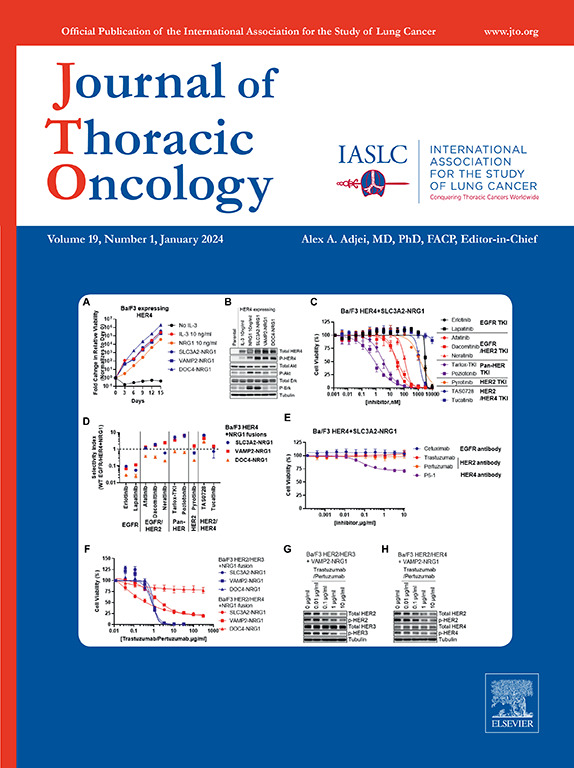Receptor Tyrosine Kinase Fusion-Mediated Resistance to EGFR TKI in EGFR-Mutant NSCLC: A Multi-Center Analysis and Literature Review
IF 21
1区 医学
Q1 ONCOLOGY
引用次数: 0
Abstract
Introduction
Drug resistance remains a major clinical challenge in EGFR-mutant NSCLC tumors owing to pathway reactivation, pathway bypass, and pathway indifference resistance mechanisms to evade tyrosine kinase inhibitor (TKI) suppression. Fusion of receptor tyrosine kinases (RTKs), such as RET, ALK, and FGFR3, has been reported to mediate EGFR TKI resistance. Given the rarity of these fusions and the heterogeneous nature of the condition, no prospective clinical trials evaluated the incidence, safety, and therapeutic benefit of dual EGFR-RTK inhibition.
Methods
We queried clinical databases from multiple institutions to identify patients who had RTK fusions detected on next-generation sequencing testing results from tissue or blood at five institutions: the Second Affiliated Hospital Zhejiang University School of Medicine, Hunan Cancer Hospital, Prince of Wales Hospital Chinese University of Hong Kong, Chao Family Cancer Center, and the University of Texas MD Anderson Cancer Center from March 1, 2016, to September 30, 2023. The data analyzed included objective response rate (ORR) to treatment post RTK fusion detection, duration of treatment, and safety. A comprehensive literature search was conducted to identify patients with RTK fusion as the primary resistance mechanism in EGFR-mutated NSCLC patients.
Results
Twenty-seven patients were identified to be eligible in the analysis. ALK fusions were most reported (42.9%), followed by RET fusions (35.7%). Fifteen patients received dual TKI after fusion detection and nine received fusion targeting single TKIs. The median time on treatment was 169 days or 5.8 months (35–1050 d). ORR by the Response Evaluation Criteria in Solid Tumors in the evaluable 25 patients was 24% and the disease control rate was 80%. In 14 evaluable patients who received dual TKI therapy, ORR by the Response Evaluation Criteria in Solid Tumors was 21.4%, and the disease control rate was 78.6%. No new toxicities were observed with dual EGFR-RTK inhibition. In the literature review, after pooling 291 patients from 59 studies, RET fusions were the most common (50.0%), followed by BRAF (13.3%), ALK (13.3%), FGFR (10%), NTRK (5.3%), EGFR (1.7%), ROS1 (1.3%), MET (1%), and ERBB (0.7%).
Conclusion
The emergence of RTK fusions is one of the mechanisms of bypass resistance of EGFR TKI. Dual inhibition of EGFR-RTK was safe and efficacious in patients with targetable RTK fusion after progression to EGFR TKIs.
egfr突变体NSCLC中受体酪氨酸激酶融合介导的EGFR-TKI耐药:一项多中心分析和文献综述
背景:在egfr突变的NSCLC肿瘤中,由于途径再激活、途径旁路和途径无差异耐药机制逃避酪氨酸激酶抑制剂(TKI)的抑制,耐药仍然是一个重大挑战。受体酪氨酸激酶(rtk)的融合,如RET、ALK和FGFR3,已被报道介导EGFR TKI抗性。鉴于这些融合的罕见性和病情的异质性,没有前瞻性临床试验评估双重EGFR-RTK抑制的发生率、安全性和治疗益处。方法:我们查询了多个机构的临床数据库,以确定2016年3月1日至2023年9月30日期间,浙江大学医学院第二附属医院、湖南肿瘤医院、香港中文大学威尔斯亲王医院、赵家癌症中心和德克萨斯大学MD安德森癌症中心(MDACC) 5个机构的组织或血液中检测到RTK融合的患者。分析的数据包括RTK融合检测后治疗的客观缓解率(ORR)、治疗持续时间和安全性。我们进行了全面的文献检索,以确定在egfr突变的非小细胞肺癌患者中,RTK融合是主要的耐药机制。结果:27例患者符合分析条件。ALK融合最多(42.9%),其次是RET融合(35.7%)。融合检测后双TKI 15例,单TKI融合9例。治疗中位时间为169天(35 - 1050,5.8个月)。可评估的25例中,RECIST的ORR为24%,疾病控制率(DCR)为80%。在14名接受双TKI治疗的可评估患者中,RECIST的ORR为21.4%,DCR为78.6%。EGFR-RTK双重抑制未发现新的毒性。在文献综述中,在汇集了59项研究的291例患者后,RET融合最常见(50.0%),其次是BRAF(13.3%)、ALK(13.3%)、FGFR(10%)、NTRK(5.3%)、EGFR(1.7%)、ROS1(1.3%)、MET(1%)和ERBB(0.7%)。结论:RTK融合的出现是EGFR TKI旁路抵抗的机制之一。在EGFR TKIs进展后可靶向RTK融合的患者中,双重抑制EGFR-RTK是安全有效的。
本文章由计算机程序翻译,如有差异,请以英文原文为准。
求助全文
约1分钟内获得全文
求助全文
来源期刊

Journal of Thoracic Oncology
医学-呼吸系统
CiteScore
36.00
自引率
3.90%
发文量
1406
审稿时长
13 days
期刊介绍:
Journal of Thoracic Oncology (JTO), the official journal of the International Association for the Study of Lung Cancer,is the primary educational and informational publication for topics relevant to the prevention, detection, diagnosis, and treatment of all thoracic malignancies.The readship includes epidemiologists, medical oncologists, radiation oncologists, thoracic surgeons, pulmonologists, radiologists, pathologists, nuclear medicine physicians, and research scientists with a special interest in thoracic oncology.
 求助内容:
求助内容: 应助结果提醒方式:
应助结果提醒方式:


